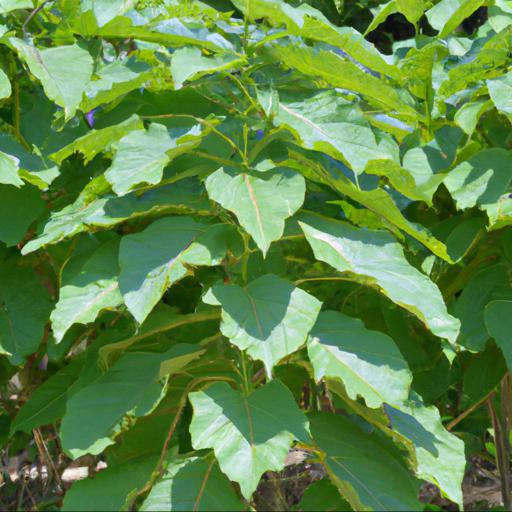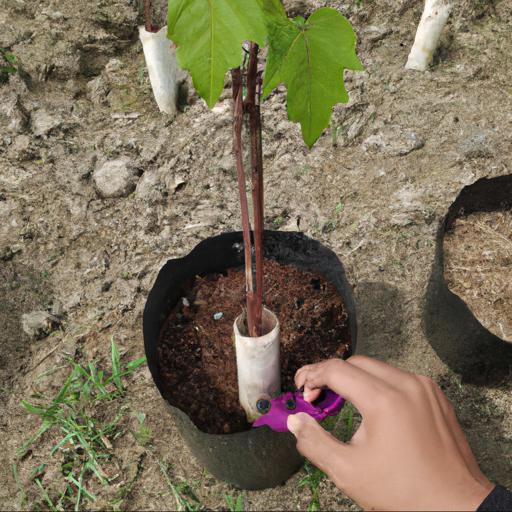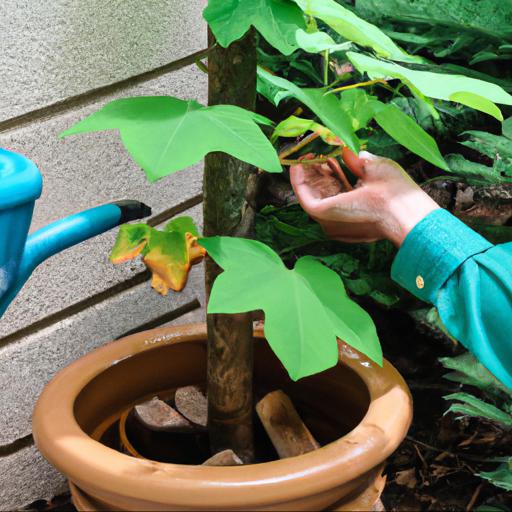Paulownia tomentosa, commonly known as the Empress Tree, is a fast-growing deciduous tree native to China. It is a popular ornamental tree due to its large, heart-shaped leaves and fragrant purple flowers that bloom in late spring. The Empress Tree has many uses, from providing shade and shelter to being used as a source of wood for furniture and other products.
This tree is also known for its ability to thrive in a variety of climates and soils, making it a great choice for gardeners and landscapers alike. In addition to its attractive appearance and hardiness, Paulownia tomentosa is also known for its medicinal benefits, as its leaves and bark have been used for centuries in traditional Chinese medicine.
Benefits of growing paulownia tomentosa

Paulownia tomentosa, often referred to as the Empress Tree, is a hardy and fast-growing deciduous tree species native to east and central Asia. The rapid growth rate, coupled with its resistance to wind, salt, and polluting agents, makes Paulownia tomentosa a popular choice for landscaping and garden projects.
It is also prized for its ornamental appeal and has become increasingly popular in recent years. There are many benefits to planting Paulownia tomentosa. It has a fast growth rate and is capable of reaching up to 15 feet in height in the first few years.
Additionally, the tree is highly versatile and can be used for landscaping in a variety of climates. The wood is also dense, durable and resistant to rot, making it ideal for furniture and craft projects.
In terms of environmental benefits, growing Paulownia tomentosa is highly sustainable; it is capable of rapidly absorbing carbon dioxide, formaldehyde, and other pollutants from the atmosphere, making it a valuable choice for urban landscaping projects. The tree is also resistant to insect damage, helping to ensure a healthy, pest-free landscape. Finally, the tree produces large and fragrant purple blooms in early summer that attract local wildlife, while its fast removal of pollutants helps keep the local environment safe and healthy.
In conclusion, it is clear that the benefits of growing Paulownia tomentosa outweigh any potential drawbacks. Its rapid growth rate, strong resistance to wind, salt, and pollution, and its ornamental appeal make it an ideal choice for landscaping projects.
Additionally, due to its ability to absorb pollutants, increased sustainability, and pest resistance, it is an invaluable choice for urban landscaping projects.
How to plant paulownia tomentosa

Planting Paulownia tomentosa, also known asroyal paulownia and Chinese empress, may sound daunting at first, but with a little guidance and enthusiasm, anyone can transform their garden into an oasis of greenery. Paulownia tomentosa is a fast-growing tree, with leaves resembling the shape of a flame, and long clusters of purple flowers. To have the most successful results, Paulownia tomentosa should be planted in full sun and well-drained soil, preferably with a pH of
5-
When planting, ensure that the hole is at least twice the size of the root ball, while also taking care to spread out the roots before backfilling with soil. Taking time to properly prepare the soil will pay off, as Paulownia tomentosa is an incredibly resilient tree that can even adapt to harsh climates. Furthermore, one should be sure to give the tree additional care when it is first planted.
Watering the tree for the first year after planting is crucial for the growth and overall health of the tree. As the tree continues to grow its impressive canopy of leaves, it is also important to keep an eye out for pests like caterpillars, and treat the affected area with an insecticide.
In conclusion, planting Paulownia tomentosa is sure to be an enriching experience. With the right environment and a bit of care, one can expect to see bursts of purple blossoms and vibrant foliage that will add character and depth to their garden. Happy planting!
How to care for paulownia tomentosa

As a UK garden expert, I would like to take this opportunity to shed some insight on caring for Paulownia tomentosa. This beautiful, fast-growing tree is an excellent choice for gardeners looking to quickly add shade, height and colour to their outdoor space.
With its vibrant purple blooms and distinctive heart-shaped leaves, it’s no wonder that Paulownia tomentosa is a popular addition to UK gardens. In order to fully appreciate the many benefits of this attractive tree, gardeners must ensure it receives the proper amount of care and attention. Here are some tips for taking care of a Paulownia tomentosa tree: First, the tree should be planted in an area that receives at least some direct sunlight each day.
Paulownia tomentosa will not thrive in areas that are too shaded or exposed to strong winds. Other considerations include plenty of moisture and soil that is slightly acidic (pH 5-6). Once the tree is planted, robust growth and healthy foliage can be ensured with regular watering and fertilisation.
Watering should be done at least once or twice a week, and it’s important to check the soil beforehand to make sure it isn’t too dry. Fertiliser should be used in moderation and applied at the base of the tree every two weeks.
Finally, the leaves of a Paulownia tomentosa need to be pruned occasionally to help maintain the tree’s overall shape. Pruning should be done when the flowers have wilted and the fruits have formed. Dead branches should be removed, as well as any weak or diseased branches.
When pruning, make sure to use a pair of garden shears or a saw to ensure a clean, smooth cut. By following these simple steps, any gardener can enjoy the beauty of the Paulownia tomentosa.
With a bit of love and care, this tree can provide glorious colour and shade to any UK garden.
Common problems with paulownia tomentosa
As a UK garden expert, I can confidently say that Paulownia tomentosa, more commonly known as the “empress tree,” is a timeless classic among gardeners. Its quick growth, beautiful bloom and unmistakable silhouette make it a favorite of experienced gardeners.
Despite its many virtues, however, there are some common problems that gardeners should be aware of when growing this tree. The Paulownia tomentosa is renowned for its fast growth and resilience. However, in certain climates, the tree can become invasive, jeopardizing native plant species and throwing off the delicate balance of an ecosystem.
In the UK, these invasives are mainly found in parts of Scotland and North Wales where temperatures are often warm and humid and growing conditions are optimal. Gardeners should, therefore, be mindful of where they introduce these trees. It is also important to be aware that the Paulownia tomentosa has a tendency to drop both its leaves and fruits indiscriminately.
In some cases, the falling leaves and fruits can create a messy and hazardous environment by obstructing paths, risking fatalities by blocking visibility, or damaging vehicles by blocking gutters and drains. Gardeners should, therefore, ensure that any branches or foliage that could create these hazards are pruned regularly.
Finally, the Paulownia tomentosa is prone to boring insects such as ambrosia beetle, which can quickly decimate an entire tree. These insects leave holes in the bark, causing an interruption to the tree’s water, nutrient, and overall energy flow. Once established, these pests can quickly spread throughout the tree, leaving the gardeners with no option but to remove the infected tree to contain the infestation.
In conclusion, the Paulownia tomentosa is a delightful addition to any garden, but there are a few common problems that may crop up during the lifespan of the tree. Gardeners should be mindful of its potential to spread and need to ensure regular pruning and pest control to ensure the tree remains healthy.
Our video recommendation
Bottom Line
Paulownia tomentosa is a fast-growing tree native to China. It has a long history of use in Asia for furniture, construction and papermaking.
It is also a popular ornamental tree, with its large, heart-shaped leaves and fragrant, bell-shaped flowers. Its fast growth rate and drought tolerance make it an attractive choice for landscaping and windbreaks. Paulownia tomentosa is an excellent choice for those looking for a fast-growing tree that is both ornamental and useful.
FAQ
What are the common names for Paulownia tomentosa?
The common names for Paulownia tomentosa are Empress Tree, Princess Tree, and Foxglove Tree.
What are the benefits of planting Paulownia tomentosa?
The benefits of planting Paulownia tomentosa include rapid growth, drought tolerance, soil improvement, and wildlife habitat. It also provides shade, windbreaks, and erosion control. Additionally, it is a valuable timber tree and can be used for firewood.
What is the growth rate of Paulownia tomentosa?
The growth rate of Paulownia tomentosa is very fast, with some trees growing up to 10 feet in a single growing season.
What is the ideal soil type for Paulownia tomentosa?
The ideal soil type for Paulownia tomentosa is well-drained, fertile, and slightly acidic soil with a pH of 6.0 to 6.5.
What is the ideal climate for Paulownia tomentosa?
The ideal climate for Paulownia tomentosa is warm and humid with full sun exposure. It prefers temperatures between 10-30°C (50-86°F) and can tolerate some frost.
How long does it take for Paulownia tomentosa to reach maturity?
Paulownia tomentosa typically takes between 3 and 5 years to reach maturity.

